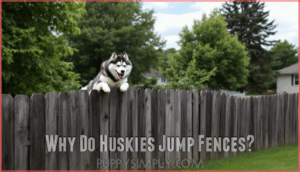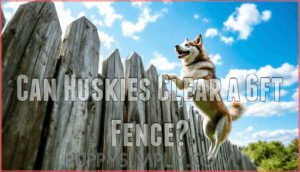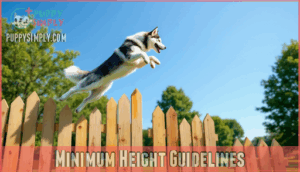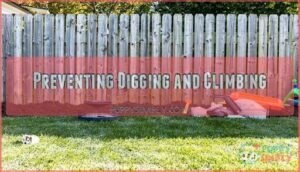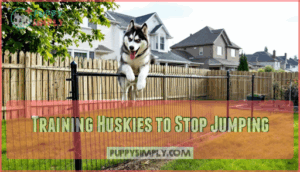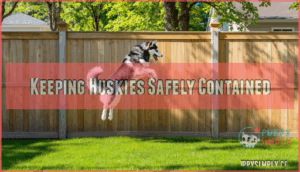This site is supported by our readers. We may earn a commission, at no cost to you, if you purchase through links.

This jumping ability stems from their sled-dog heritage, where powerful hindquarters and lean muscle helped them navigate rough Arctic terrain.
Understanding your husky’s vertical reach isn’t just trivia—it’s essential for preventing escapes, protecting your dog from injury, and designing containment that actually works. Whether you’re installing a fence or stopping unwanted jumping behavior, knowing what your husky can physically achieve helps you stay one step ahead.
Table Of Contents
- Key Takeaways
- How High Can Huskies Jump?
- What Makes Huskies Strong Jumpers?
- Why Do Huskies Jump Fences?
- Can Huskies Clear a 6ft Fence?
- Recommended Fence Height for Huskies
- Training Huskies to Stop Jumping
- Keeping Huskies Safely Contained
- Additional Tips for Husky Owners
- Frequently Asked Questions (FAQs)
- What health risks are associated with huskies jumping?
- How can I train my husky puppy not to be a jumper?
- Are some husky breeds better jumpers than others?
- What toys can I provide to distract my husky from jumping?
- If my husky does escape, what is the best way to find them?
- Do Huskies jump higher than German Shepherds?
- What age do Huskies start jumping high?
- Can overweight Huskies jump as high?
- Do female Huskies jump lower than males?
- How does spaying affect Husky jumping ability?
- Conclusion
Key Takeaways
- Most huskies jump 4 to 4.5 feet from a standing position, but athletic individuals with running starts can clear 6 feet or higher, making standard fencing insufficient for preventing escapes driven by prey drive, boredom, or their bred-in desire to roam.
- A minimum 6-foot fence is recommended for huskies, but height alone won’t stop them—you’ll need solid materials that prevent climbing, buried barriers to block digging, and secure gates since their sled-dog heritage gives them the strength and determination to exploit any weakness.
- Training huskies to stop jumping requires consistent obedience commands, immediate positive reinforcement when all four paws stay grounded, and at least 90 minutes of daily vigorous exercise to redirect their energy away from escape attempts.
- Repeated jumping from heights risks joint damage like hip dysplasia and arthritis, especially in puppies with developing growth plates, so managing their jumping behavior protects both their immediate safety and long-term health.
How High Can Huskies Jump?
If you’ve ever watched a Husky eye a fence with that mischievous glint, you’re probably wondering just how high these athletic dogs can actually jump. The answer depends on several factors, from their physical build to their motivation level.
Let’s look at what typical Huskies can achieve, what the most athletic ones have accomplished, and how they stack up against other breeds.
Typical Jump Height for Huskies
Most Siberian huskies can jump vertically between 4 and 4.5 feet from a standing position without training. Your husky’s jumping ability depends on several factors that affect this average clearance:
- Age and fitness level — Young, healthy adults jump higher than puppies or seniors
- Body proportions — Longer-legged huskies generate more upward power
- Motivation — Prey drive and excitement push physical capacity beyond baseline
- Jumping styles — Many combine vertical leap with climbing, reaching even higher
Athletic huskies often exceed this vertical range, especially during play or pursuit scenarios. Some huskies can jump even higher, thanks to their strong legs and lungs.
Maximum Recorded Jumps
While typical jumps reach 4 to 4.5 feet, huskies have cleared considerably higher barriers under the right conditions. Documented cases show these dogs jumping or climbing combinations over 6-foot fences when motivated by excitement or prey drive. Some athletic individuals have cleared 8 feet with a running start, though there’s no Guinness World Record specifically for husky jump heights.
The overall canine jump record stands at 75.5 inches by a Greyhound—proving dog jumping ability varies widely across breeds and situations.
Comparison to Other Breeds
When stacking Huskies against other athletic breeds, their dog jumping ability falls somewhere in the middle. Border Collies vs. Huskies shows Collies routinely clearing 6 feet in agility trials, while Malinois vs. Huskies reveals Belgian Malinois can hit 8 feet vertically—sometimes even scaling 10-foot walls. Greyhounds vs. Huskies highlights the record holder at 6 feet 2 inches. Australian Shepherds vs. Huskies shows similar ranges (4.5 to 5 feet), and surprisingly, Jack Russell Terriers vs. Huskies proves small dogs can match or exceed Husky heights despite their size.
Huskies excel at combining jumping with climbing, making dog jumping the fence a persistent challenge. Their athleticism contributes to their significant jumping ability.
What Makes Huskies Strong Jumpers?
Huskies aren’t just good jumpers by accident—their bodies are built for it. Their powerful legs, athletic background, and overall health all play into how high they can leap.
Let’s look at what gives these dogs their impressive vertical ability.
Physical Characteristics and Muscle Power
Huskies pack impressive muscle power in their legs, a legacy of their breeding as endurance athletes built to haul sleds across frozen terrain. Their medium body size gives them an ideal strength-to-weight ratio—males usually weigh 45–65 pounds with strong hindquarters that generate explosive upward force.
Muscle coordination and leg power work together during jumping mechanics, allowing Siberian huskies to spring vertically with considerable ease. This physical characteristic makes dog jumping ability particularly pronounced in the breed.
Breed Origins and Athleticism
Centuries of work in Siberia’s harshest conditions shaped these dogs into natural athletes, where survival depended on speed, stamina, and the ability to navigate treacherous landscapes. Their sled-dog heritage demanded remarkable endurance capabilities and muscular development throughout generations.
Siberian huskies retain these athletic builds today, with breed standards emphasizing their historical roles as working dogs. These breed-specific traits directly influence dog jumping ability, making them naturally skilled at clearing obstacles.
Age and Health Factors
Even the fittest Husky won’t jump as high once age or health issues start taking their toll on those powerful legs. Puppies face jump risks from underdeveloped coordination and bones, while seniors hit jumping limits due to arthritis impact, hip dysplasia, or muscle atrophy.
Joint issues and physical limitations greatly reduce canine health and vertical ability, meaning dog jumping and age—plus overall dog jumping and health—directly determine what your Husky can clear.
Why Do Huskies Jump Fences?
If you’ve ever caught your Husky mid-leap over your fence, you’re probably wondering what’s driving this escape artist behavior. Understanding why Huskies jump isn’t just about curiosity—it’s the first step to keeping them safe and secure.
Let’s look at the main reasons your Husky might be treating your backyard like an obstacle course.
Prey Drive and Chasing Instincts
If you’ve ever watched a squirrel dart across your yard only to see your Husky launch into pursuit mode, you’ve witnessed the powerful prey drive that’s hardwired into these dogs.
Siberian huskies have a high prey drive inherited from their working ancestors, who needed to hunt for survival. This instinctual behavior triggers intense chase reactions when they spot small animals, leading to escape attempts and dogs jumping the fence before you can blink.
Boredom and Lack of Stimulation
When your Husky treats your fence like a launching pad, there’s a good chance boredom is the real culprit behind those escape attempts. Without adequate mental stimulation and exercise needs met, behavioral issues emerge fast.
Puzzle toys, interactive games, and training variety give their brains work to do, while social interaction keeps them emotionally satisfied—addressing these gaps dramatically reduces dog jumping the fence and preventing dog escapes becomes much easier.
Desire for Exploration and Adventure
Bred to roam snowy landscapes pulling sleds across vast distances, your Husky carries an adventure-seeking nature coded directly into their DNA. That genetic predisposition creates instinctual roaming urges that drive escape attempts when unmet needs pile up. Without proper mental stimulation addressing their breed purpose, Siberian huskies with energetic personalities develop behavioral issues—dog jumping the fence becomes their outlet for exploration.
Huskies jump fences not from defiance, but from DNA—sled dogs bred for vast terrain see your yard as just another landscape to explore
What fuels their wanderlust:
- The thrill of discovering new scents beyond your property line
- Seeking companionship with neighborhood dogs or wildlife
- Following intriguing sounds that trigger their curiosity
- Simply experiencing freedom their working heritage demands
Can Huskies Clear a 6ft Fence?
Most Huskies can jump around 4 to 4.5 feet from a standstill, but a 6-foot fence isn’t guaranteed to keep them in. Some athletic or determined individuals have cleared barriers that high, especially with a running start or extra motivation.
Let’s look at what actually happens when Huskies face taller fences.
Documented Cases of High Jumps
You might’ve heard stories about Siberian huskies launching themselves over tall fences, and they’re not just tall tales. With a running start, rare individuals have demonstrated jumps as high as 8 feet over obstacles.
Most athletic huskies clear 6-foot fences when motivated by prey drive or the desire to explore. These observed jump heights explain why many Husky owners discover their dog jumping the fence despite what seemed like adequate containment.
Factors Affecting Jumping Success
Not every husky clears a 6-foot fence, and understanding why some do while others don’t comes down to a few key variables. Muscle strength and joint health determine your dog’s explosive power, while breed variance means longer-legged huskies naturally generate more upward force. Age matters too—prime adults jump higher than puppies or seniors.
Motivation levels, like chasing prey or exploring, often push Siberian huskies beyond their typical dog jump heights, making even trained dogs test boundaries.
Risks of Insufficient Fencing
A fence that’s too short turns your yard into a launchpad instead of a secure zone, and the consequences go well beyond a simple escape. When Siberian huskies clear inadequate barriers, you’re facing:
- Escape dangers like traffic accidents and getting lost in unfamiliar areas
- Injury risks from landing awkwardly or encountering aggressive animals
- Legal liability if your dog damages property or injures someone
- Theft potential since loose huskies attract opportunistic strangers
Dog jumping safety starts with proper containment—don’t gamble with your dog’s health concerns.
Recommended Fence Height for Huskies
Choosing the right fence height isn’t just about keeping your Husky in—it’s about preventing escapes and keeping them safe. Most experts agree that standard fencing won’t cut it for these athletic escape artists.
Here’s what you need to know about building a secure containment system that actually works.
Minimum Height Guidelines
Most experts agree that six feet is the magic number for Siberian huskies. This expert recommendation stems from dog jumping safety data showing huskies usually clear 4 to 4.5 feet with ease.
Owner experiences confirm that Fence Height Factors like athleticism and motivation matter—some escape-prone dogs have scaled even higher.
The American Kennel Club advises six-foot barriers for Escape Prevention, since Dog Jump Heights by Breed reveal huskies’ considerable leg power from their sled-pulling heritage makes lower fences risky.
Material and Design Considerations
Once you’ve settled on the right height, the fence material and overall design become just as important to keep your husky from finding a way out. Siberian huskies are creative escape artists, so your choices matter:
- Fence Materials: Solid wood or vinyl prevents climbing better than chain-link, which huskies use like a ladder.
- Gate Security: Latch mechanisms should be husky-proof—consider locks they can’t nose open.
- Climbing Barriers: Avoid horizontal rails or footholds that ambitious dogs exploit when dog jumping becomes their mission.
Preventing Digging and Climbing
Even a well-built fence won’t stop your husky if they decide to tunnel underneath it or scale it like a four-legged rock climber. Bury wire mesh or concrete footers at least 12 inches deep to block digging deterrents. Remove climbing obstacles like nearby furniture or stacked items that training dogs to stop jumping won’t address.
Add L-footers angled inward along the fence line, and incorporate yard design elements that discourage boredom solutions—like interactive toys scattered around your secure space.
Training Huskies to Stop Jumping
Training your Husky to stop jumping takes patience, but it’s entirely achievable with the right approach. You’ll need to focus on three key areas: teaching clear commands, using rewards that motivate your dog, and making sure they’re getting enough physical activity.
Let’s look at each method so you can find what works best for your situation.
Obedience Commands and Consistency
Teaching your Husky commands like "off" and "sit" can redirect their jumping behavior, but only if you practice them with unwavering consistency. Use the same command words every time, and make sure everyone in your household follows identical rules—mixed signals confuse dogs and prevent positive outcomes.
Early socialization helps establish these patterns, while consistent training across different environments reinforces command reinforcement and prevents relapse in dog behavior.
Positive Reinforcement Techniques
Patience might feel like the slowest route to success, but rewarding your Husky with treats and praise the moment they keep all four paws on the ground turns calm behavior into a habit faster than any punishment ever could.
Treat training works best when reward timing happens within seconds—click or say "yes" instantly to mark the exact behavior you want. Clicker methods sharpen this precision, shaping behavior step-by-step without safety concerns that punishment creates in dog breeds known for sensitivity.
Redirecting Energy With Exercise
Your Husky’s urge to leap fences won’t disappear on its own—it needs an outlet, and that outlet is consistent, rigorous exercise that drains the energy fueling those escape attempts. Siberian Husky exercise requirements demand at least 90 minutes of daily walks, runs, or breed-specific activities like bikejoring.
Exercise intensity matters more than duration—mental stimulation through puzzle games prevents boredom while building stamina that channels energetic personalities away from fence-jumping.
Keeping Huskies Safely Contained
Even with training, some Huskies will test boundaries, so you’ll need backup strategies to prevent escapes. The right combination of physical upgrades, monitoring tools, and smart outdoor design can make all the difference.
Here are three proven ways to keep your Husky safely at home.
Physical Barriers and Fencing Upgrades
If you’ve decided a standard fence isn’t cutting it, upgrading to a more secure barrier can be the turning point that keeps your escape artist safely at home. Here are five upgrades that work:
- Barrier height of at least 6 feet prevents most Siberian huskies from clearing the top
- Fence materials like chain-link with no footholds discourage climbing attempts
- Dig prevention with buried wire mesh or concrete footers stops tunneling escape routes
- Gate security using self-closing latches and double locks eliminates weak points
- Invisible fences aren’t recommended—huskies’ prey drive often overpowers the correction
These modifications address dog jumping and behavior patterns specific to high-energy breeds with strong exercise needs.
Using GPS and Monitoring Tools
When your husky’s wanderlust outpaces even the best fence, a GPS collar becomes your safety net for tracking their whereabouts in real time. Modern GPS collars with geofencing alerts notify you the moment your dog crosses a boundary, while activity trackers monitor dog exercise needs and health monitoring data.
You’ll spot unusual dog behavior patterns through data analysis, ensuring your husky gets proper dog exercise and dog care while staying safe.
Creating a Secure Outdoor Space
Beyond tech solutions, the real key is designing your yard with escape-proof features from the ground up. Combine safe landscaping choices with supervised playtime to satisfy Siberian huskies’ dog exercise needs while managing dog behavior and dog health concerns:
- Install fence alternatives like reinforced barriers extending underground to prevent digging
- Add enrichment activities such as agility equipment and puzzle stations for mental stimulation
- Create secure zones with double-gated entries for escape prevention during dog jumping attempts
Additional Tips for Husky Owners
Beyond fencing and training, a few other areas deserve your attention as a Husky owner. These tips cover exercise routines, common behavioral issues, and health considerations that’ll help keep your dog happy and secure. Let’s look at each one.
Meeting Exercise Needs
Most Huskies need at least 1 to 2 hours of vigorous exercise daily to stay mentally balanced and less likely to test your fence line. Without enough physical activity, your Siberian Husky’s natural energy turns into fence-jumping fuel. Pair daily exercise with mental stimulation through interactive games and leash training to satisfy their working-dog instincts.
| Activity Type | Examples |
|---|---|
| Cardio Exercise | Running, hiking, bikejoring |
| Mental Stimulation | Puzzle toys, scent work, agility courses |
| Social Play | Off-leash dog parks (with safe recall), fetch games |
Addressing Behavioral Challenges
Sometimes, all the running and puzzle-solving in the world won’t stop a Husky who’s mastered the art of Houdini-level escapes. Behavioral issues often stem from deeper jumping triggers like anxiety or boredom. If destructive behaviors persist despite positive reinforcement and mental stimulation, consider these steps:
- Identify what sparks your dog’s jumping on furniture or fences
- Use dog training methods focused on anxiety reduction
- Maintain consistent dog behavior expectations across all family members
- Reward calm responses to previous triggers
- Seek professional help from certified dog training experts when needed
Ensuring Overall Health and Safety
A healthy Husky isn’t just one that can leap tall fences—it’s one whose joints, muscles, and overall body can withstand the physical demands that come with their athletic nature. Regular vet checkups catch issues like hip dysplasia and eye problems early. Safe exercise routines, proper diet considerations, and monitoring for heatstroke protect your Siberian Huskies from injury while supporting joint health, mental wellbeing, and injury prevention.
| Health Priority | Why It Matters |
|---|---|
| Joint health monitoring | Prevents arthritis and hip dysplasia from repetitive jumping |
| Injury prevention practices | Reduces strain on muscles and ligaments during activity |
| How much exercise to provide | Balances energy needs without overexertion |
| Mental wellbeing support | Decreases anxiety-driven jumping and escape attempts |
Frequently Asked Questions (FAQs)
What health risks are associated with huskies jumping?
While dogs love leaping, repeated jumps stress growing joints. Siberian huskies risk hip dysplasia and arthritis from excessive jumping, especially as puppies when growth plates haven’t closed.
Spinal injuries occur when landing incorrectly from heights.
How can I train my husky puppy not to be a jumper?
Start training early using positive reinforcement—reward calm behavior with treats and praise. Teach commands like "off" and "sit" for consistency.
Redirect jumping energy through leash training, mental stimulation, and crate training to shape your Siberian Husky’s temperament and prevent furniture-jumping habits.
Are some husky breeds better jumpers than others?
Within the Siberian husky breed, jumping prowess is remarkably consistent—there aren’t distinct "husky breeds." However, individual dogs vary based on breeding lines, training impact jumps, and physical conditioning, not subspecies differences.
What toys can I provide to distract my husky from jumping?
Puzzle toys and durable chew options keep your husky mentally engaged, redirecting their energy away from jumping.
Interactive games like fetch toys and training treats during dog exercise sessions satisfy the Siberian Husky temperament’s need for activity and challenge.
If my husky does escape, what is the best way to find them?
Contact local shelters immediately and check your microchip registration. Post on community social media with photos emphasizing Siberian Husky characteristics and temperament.
GPS tracking collars prevent this—install one today for instant location access during lost husky recovery efforts.
Do Huskies jump higher than German Shepherds?
Both breeds have similar vertical jumping ability, usually clearing 4 to 6 feet. However, individual German Shepherds often show slightly greater jumping motivation and training responsiveness, while Huskies possess remarkable leg power from their sled-pulling heritage but jump primarily when seeking adventure.
What age do Huskies start jumping high?
Around six months, adolescent jump height starts increasing as joint development progresses. Puppy jumping age begins earlier, but Husky growth stages and Siberian Husky temperament mean serious vertical ability emerges during adolescence—when dog training and managing dog exercise needs become essential.
Can overweight Huskies jump as high?
Overweight dogs face reduced agility and joint stress that greatly limit vertical leap capability.
Obesity impacts a Siberian husky’s temperament and exercise needs, creating a cycle where excess weight restricts movement, which can worsen dog health issues over time.
Do female Huskies jump lower than males?
Sex differences in jumping ability between male and female huskies are minimal. Female huskies usually jump just as high as males despite being slightly smaller.
Physical characteristics like leg length and motivation levels matter more than gender when determining jumping technique and height comparison.
How does spaying affect Husky jumping ability?
Like a spring compressed by weight, spaying doesn’t directly weaken your Husky’s jumping power—but hormonal changes can slow metabolism, leading to weight gain.
Post-surgery recovery requires limited activity levels temporarily. Extra pounds strain joints, reducing athletic performance over time without proper weight management and exercise.
Conclusion
Your husky’s athleticism is both a marvel and a challenge—they’re built to leap high, but that doesn’t mean every fence needs to become their personal obstacle course. Understanding how high huskies jump gives you the upper hand in designing spaces that keep them safe without stifling their spirit.
With the right fencing, training, and outlets for their energy, you’ll transform their escape artist tendencies into manageable behavior. A secure yard isn’t about limiting their freedom—it’s about giving them room to thrive without the risks.


